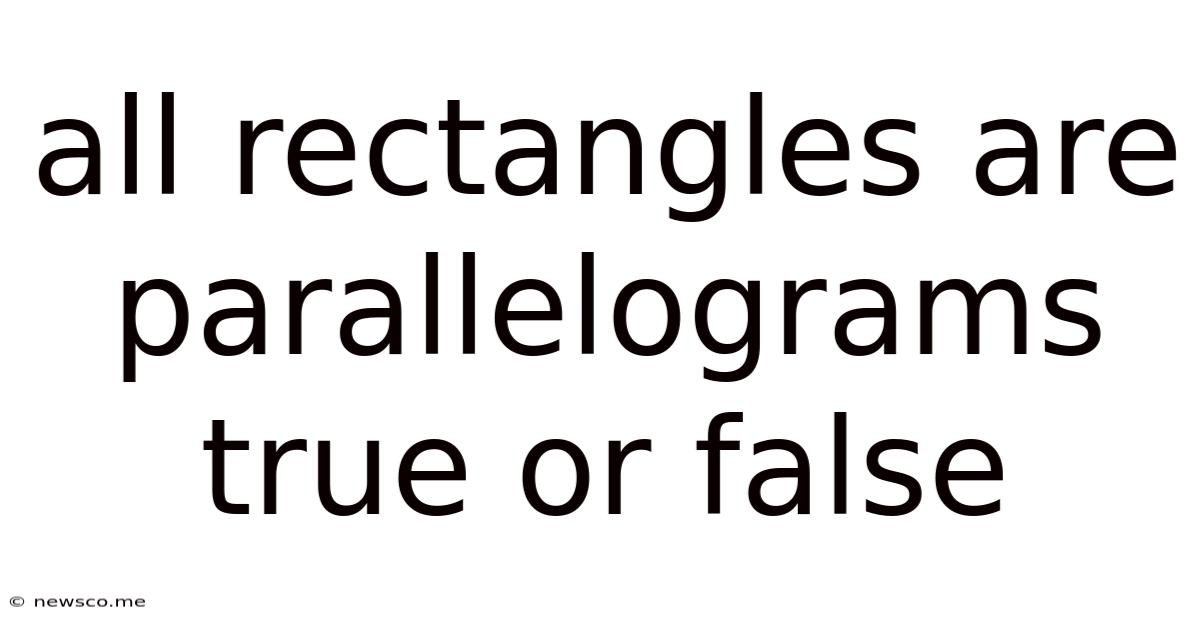All Rectangles Are Parallelograms True Or False
News Co
Apr 10, 2025 · 4 min read

Table of Contents
All Rectangles Are Parallelograms: True or False? A Deep Dive into Quadrilateral Geometry
The statement "All rectangles are parallelograms" is unequivocally true. This seemingly simple assertion forms the foundation of understanding quadrilateral geometry and the relationships between various shapes. This article will delve into the properties of rectangles and parallelograms, proving the truth of this statement and exploring the broader implications within the realm of geometric concepts. We will also touch upon related concepts and address common misconceptions.
Understanding Parallelograms
Before we tackle the central question, let's solidify our understanding of parallelograms. A parallelogram is defined as a quadrilateral (a four-sided polygon) with opposite sides parallel. This seemingly simple definition has several important consequences:
Key Properties of Parallelograms:
- Opposite sides are parallel: This is the defining characteristic.
- Opposite sides are congruent (equal in length): A direct result of the parallel sides.
- Opposite angles are congruent: Another consequence of the parallel sides.
- Consecutive angles are supplementary: Meaning that their sum equals 180 degrees.
- Diagonals bisect each other: The diagonals intersect at their midpoints.
These properties are crucial for identifying and working with parallelograms in various geometric problems. Understanding these properties is foundational to understanding the relationship between parallelograms and other quadrilaterals, such as rectangles, rhombuses, and squares.
Defining Rectangles
Now, let's turn our attention to rectangles. A rectangle is defined as a quadrilateral with four right angles. This seemingly simple additional property has profound implications for the shape and properties of the figure.
Key Properties of Rectangles:
- Four right angles: This is the defining characteristic.
- Opposite sides are parallel: This is a direct consequence of having four right angles.
- Opposite sides are congruent: This follows from the parallel sides.
- Diagonals are congruent: Unlike general parallelograms, the diagonals of a rectangle have equal lengths.
- Diagonals bisect each other: This property is inherited from the parallelogram family.
Proving the Relationship: All Rectangles are Parallelograms
The statement "All rectangles are parallelograms" is true because a rectangle fulfills all the requirements of a parallelogram. Let's break this down:
- The Defining Property of a Parallelogram: A parallelogram is defined by having opposite sides that are parallel.
- Rectangles and Parallel Sides: A rectangle, by its definition (four right angles), automatically satisfies the condition of having opposite sides parallel. This is due to the properties of parallel lines and transversal lines: the lines forming the sides of the rectangle are intersected by the other sides (transversals), and the resulting right angles demonstrate parallel relationships.
Therefore, since a rectangle possesses the defining characteristic of a parallelogram (opposite sides parallel), it is inherently classified as a parallelogram. This means rectangles are a subset of parallelograms; they are a more specific type of parallelogram.
Visualizing the Relationship
Imagine a Venn diagram. The larger circle represents all parallelograms. Within this larger circle, a smaller circle representing rectangles completely lies within the parallelogram circle. This illustrates that every rectangle is also a parallelogram, but not every parallelogram is a rectangle.
Expanding the Family: Rhombuses and Squares
The quadrilateral family extends beyond rectangles and parallelograms. Rhombuses and squares are also special types of parallelograms:
- Rhombus: A parallelogram with four congruent sides.
- Square: A parallelogram with four congruent sides and four right angles.
Notice that a square is a special case of both a rectangle and a rhombus. It inherits all the properties of both. This illustrates the hierarchical nature of these geometric shapes.
Common Misconceptions
A common misconception stems from the fact that not all parallelograms are rectangles. Students often confuse the inclusion relationship. Remember, the statement "All rectangles are parallelograms" is true, but the converse "All parallelograms are rectangles" is false.
Applications in Real-World Scenarios
The understanding of parallelograms and rectangles is crucial in many real-world applications:
- Architecture and Construction: Designing buildings, bridges, and other structures often involves using rectangular and parallelogram-shaped components. Understanding their properties is essential for structural integrity.
- Engineering: Parallelograms and rectangles play a vital role in mechanical design, particularly in linkages and mechanisms.
- Computer Graphics: Representing shapes and objects on computer screens relies heavily on geometric principles, including understanding parallelograms and rectangles.
- Art and Design: Parallelograms and rectangles are frequently used in art and design to create visual balance and structure.
Conclusion: A Foundation of Geometry
The statement "All rectangles are parallelograms" is fundamentally true, stemming directly from the definitions and properties of these quadrilaterals. This understanding forms a cornerstone of geometric reasoning and has widespread applications in various fields. Mastering these concepts is essential for anyone pursuing studies or professions that involve geometry, engineering, design, or related disciplines. Understanding this seemingly simple truth reveals the intricate and fascinating relationships within the family of quadrilaterals. By understanding these relationships, we can build a solid foundation in geometry, enabling us to tackle more complex geometric challenges with confidence and proficiency. The key takeaway is that this simple statement encapsulates a much deeper understanding of geometric relationships and their practical implications.
Latest Posts
Related Post
Thank you for visiting our website which covers about All Rectangles Are Parallelograms True Or False . We hope the information provided has been useful to you. Feel free to contact us if you have any questions or need further assistance. See you next time and don't miss to bookmark.